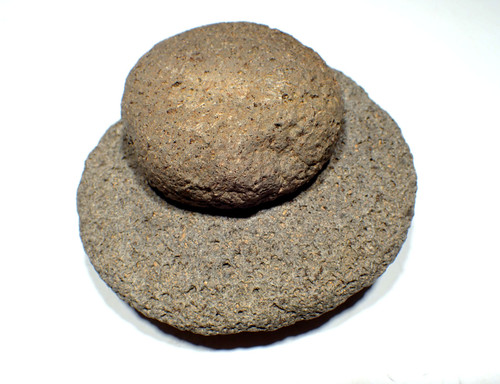Product Description
SEE MORE AFRICAN NEOLITHIC ARTIFACTS
On a dinosaur fossil-hunting expedition in 2000 by a team of scientific explorers led by Paul Sereno, a paleodune and ancient lakebed site was discovered that yielded over 200 ancient burials of Kiffian and Tenerian people. The scientific findings showed that this area was once a humid lake region that was home to a hunter-fisher-gatherer people. The area became known as the "Green Sahara" for its once fertile and habitable landscape. Noted paleontologist, Dr. Paul Sereno, famous for other Saharan dinosaur discoveries, shot into the archaeological spotlight with his discovery of the ancient lakebed cemetery at Gobero in Niger in the year 2000. Interred in the many burials were numerous stone tools, ceramics, shells, beads and bone harpoons typical for the lifestyle of these ancient people of the Green Sahara. This RARE and exceptional AUTHENTIC artifact is similar to the specimens found at Gobero. It comes from the same period and Tenerian Neolithic Culture of that famous discovery.
This grooved stone polisher is a rare African Neolithic tool used to manufacture and polish stone art objects, beads, pendants, and projectile points in the Tenerean Neolithic Culture. Made from a small basalt cobble stone, it was selected based on its natural shape, and further shaped by pecking the base to flatten it. A rounded groove was ground into the top face of it. This makes it ideal to smoothly shape and polish a variety of wood, bone, ivory and stone objects. The entire stone has an amazing 'Desert Varnish' patina and small pocking from wind erosion due to exposure in the desert for thousands of years. It is in perfect, complete form as originally made with no modern damage or alterations. AN IMPORTANT STONE TOOL INTENDED FOR THE LUXURY CREATION OF ART OBJECTS, NOT A NECESSITY FOR SURVIVAL.
African Neolithic stone grooved polishers are an uncommon artifact. They were used to further shape roughly hand-formed a variety of materials. The carving object would have been rubbed back and forth in the groove of the tool with the aid of a sand slurry, to smooth and polish the stone into the desired shape. Some polishers had multiple grooves, perhaps for different sizes of grit, allowing a rougher polish in one groove and a finer polish in the other.
We have seen numerous fake examples of these in the marketplace. When examined under magnification, fakes will have evidence of modern grinding marks on the surface in the grooves, and lack any natural mineral deposits deep in microscopic crevices. An authentic example like this will lack ANY evidence of recent grinding marks as seen above.
The region where Tenerian artifacts were once found is now protected preventing any collecting. Furthermore, it is located in extremely dangerous open desert regions under constant unrest occupied by armed bandits and terrorists. We were very fortunate to have acquired an old French private collection of these artifacts by former expedition guides to the region in the 1960's and 1970's. We have a very limited amount and once sold, we will never be able to replace them. Objects from the Tenerian African Neolithic culture are so rare that not even most major museums have a single object in their collection.
HISTORY
The Earth has been warming and cooling for millions of year, well long before humans were on the planet. One of the most dramatic examples of climatic change in the last 10,000 years is the desiccation of what is now the Sahara desert. Prior to as recent as 3000 B.C., the South Central Sahara region in Africa was a humid lake savanna. It was home to a thriving culture of ancient humans known as the Tenerians and before them, the Kiffians. The occupation of this area by these two peoples occurred continuously from around 7700 B.C. to the drying of the Sahara in 2500 B.C..
In the final Pleistocene and early Holocene Periods around 10,000 years ago, the South Central Sahara Desert was once a highly favorable environment for hunters, gatherers and pastoralists. Freshwater lakes existed between the dunes in what is now the Tenere region, Lake Chad was eight times its current size, the highlands supported Mediterranean forest trees, and a diverse variety of both large and small fauna flourished there. The slow drying out process of the Sahara, began 7,000 years ago and ended 4500 years ago resulting in the barren conditions that exist to this day. As we progress through time from the end of the Pleistocene towards the end of the Neolithic Period there, we see humans relying more on meat from raised animals as opposed to hunted animals that once roamed wild in the formerly Green Sahara.
 US DOLLAR
US DOLLAR
 EURO
EURO
 AUSTRALIAN DOLLAR
AUSTRALIAN DOLLAR
 CANADIAN DOLLAR
CANADIAN DOLLAR
 POUND STERLING
POUND STERLING


















